Elements of Neon
Now that I've told you the story of Kamigawa: Neon Dynasty's design (Part 1 and Part 2) and shown off the vision design handoff document (Part 1 and Part 2), it's time for a column of card-by-card design stories from the set.
Jin-Gitaxias, Progress Tyrant
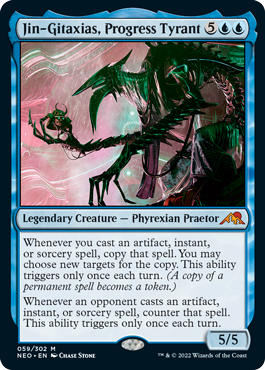
One of the challenges of Magic design is that sometimes you do something offbeat, the audience really likes it, and one day you return to it beholden to that quirky design. Such are the Phyrexian Praetors. They premiered in New Phyrexia, where I came up with the crazy idea that they should have two abilities, one that helped you and a mirror of that first ability that hurt the opponent.
The Phyrexian Praetors ended up cool, but even to do five, we stretched the color pie quite a bit. So, the idea of doing more Praetor designs was daunting, but we felt there would be such a high expectation for it that we didn't have a choice. I just wanted to set all this up before we got to talking about Jin-Gitaxias's design.
Jin-Gitaxias, Reality Hacker (version 1)
4UU
Legendary Creature — Praetor
5/4
Artifact, instant, and sorcery spells you cast cost 2 less to cast.
Artifact, instant, and sorcery spells your opponents cast cost 2 more to cast.
The first pass made your artifacts, instants, and sorcery spells cheaper while making your opponents' more expensive. We allow colors to cost-reduce for subsets they focus on, so the first ability was fine. Blue is second to white on taxing, so the second ability was also acceptable. The whole package just wasn't that fun to play. It came out late enough that the spell reduction wasn't that important and the taxing could often be played around.
Jin-Gitaxias, Reality Hacker (version 2)
2UU
Legendary Creature — Phyrexian Praetor
3/4
Flash
Each opponent's maximum hand size is reduced by 2.
At the beginning of your end step, if you have fewer than two cards in hand, draw cards equal to the difference.
The next attempt helped you out by drawing cards while preventing the opponent from keeping all of theirs in their hand. Messing with hand size is done in blue, but usually for making it bigger rather than shrinking it. Drawing cards is always fine for blue. This design had a couple problems. One, it was a little like the first Jin-Gitaxias, which also shrunk hand size. Two, the two abilities didn't feel as mirrored as we liked. Three, it again didn't play great. I should note that this version did make Jin-Gitaxias cheaper and smaller.
Jin-Gitaxias, Reality Hacker (version 3)
5UU
Legendary Creature — Phyrexian Praetor
5/4
Flash
Whenever you cast a spell, copy that spell. (A copy of a permanent spell becomes a token.)
Whenever an opponent casts their first spell each turn, counter that spell.
The next version played in very clean blue design space, copying and countering spells. The design team liked this version but made a couple tweaks. First, they reduced the cards affected to just artifacts, instants, and sorceries. I think this was because the unbounded copying was a little too much. Second, they changed it from a 5/4 to a 5/5. I hope Jin-Gitaxias can create as much trouble in your games as he has in the story.
The Kami War // O-Kagachi Made Manifest
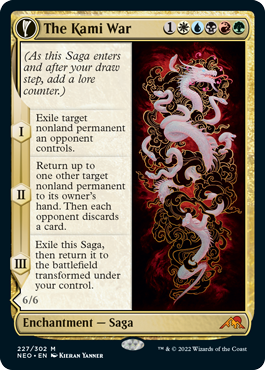
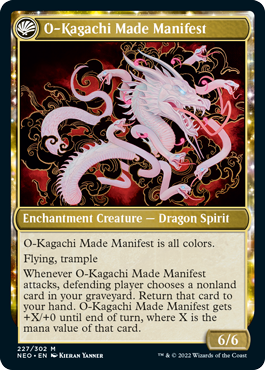
One of the fun things about adding Sagas to the set was that we had an opportunity to tell stories from our original visit to the plane. The Kami War tells the biggest story from Champions of Kamigawa block, the war between the Humans and the Spirits.
Supreme Warrior (version 0)
3RG
Legendary Enchantment Creature — Shaman
6/6
Paragon 3RG (If you cast this card for its paragon cost, it's an Aura spell with enchant creature. Enchanted creature is a copy of this card. If that creature would be destroyed, instead remove all damage from it and destroy this Aura.)
5RR: CARDNAME deals 4 damage to any target.
One of the fun things about looking back at the history of card slots in our database is that we get to find things that existed before the current card. In this case, we get a peek at a mechanic we experimented with in vision design but cut from the set. That mechanic was called Paragon. It went on creatures and allowed you to essentially turn any of your existing creatures into this creature with a reduced cost. The mechanic was flavorful and played into our enchantment theme, but, in practice, mostly played like having an alternate cost that required a creature sacrifice. It just ended up being a little too many words for not enough payoff.
O-Kagachi's Rampage (version 1)
WUBRG
Legendary Enchantment — Saga
I: Each player sacrifices four nonland permanents.
II: Return target Spirit or enchantment card from your graveyard to your hand.
III: This permanently becomes a Dragon Spirit creature (6/6). Whenever you attack with one or more Spirit creatures, draw that many cards.
The first version established the WUBRG cost and set up the basic mechanical structure for the Saga. The first chapter is destructive. The second chapter brings back something from the graveyard. The third chapter turns the card into a Spirit Dragon. At this point, the Sagas only had one side and the card just turned into the Dragon, so it was a 6/6 with the Spirit tribal text. This version ended up being a little too destructive.
O-Kagachi's Rampage (version 2)
WUBRG
Legendary Enchantment — Saga
I: Destroy any number of target permanents with different controllers.
II: Return target Spirit or enchantment card from your graveyard to your hand.
III: This permanently becomes a Dragon Spirit creature (5/5). Whenever you attack with one or more Spirit creatures, draw that many cards.
The second version tweaked the first chapter, making it less destructive in a two-player game but allowing it to scale to the number of players in multiplayer. It also shrunk the Spirit Dragon from 6/6 to 5/5.
O-Kagachi's Rampage (version 3)
WUBRG
Legendary Enchantment — Saga
I: Each other player sacrifices a nonland permanent they control with the greatest mana value.
II: Return target Spirit card from your graveyard to your hand.
III: This permanently becomes a Dragon Spirit creature (5/5) with flying. Whenever you cast a Spirit spell, draw a card.
The third version again changes the first chapter, now destroying the permanents with the highest mana value rather than letting you choose. The second ability lost the ability to return enchantments to your hand. The last ability added flying (I think this was just an oversight, as Dragons in Magic can fly) and tweaked the Spirit tribal effect.
The last big change made for the version that got printed tweaked the chapter one destruction to just be a single destruction effect of your choice. I think the mutual destruction proved hard to work around. We added to what could be returned with the second ability but with a discard effect, albeit for all players. The third ability was the biggest change. The Set Design team decided to make the Sagas double-faced cards, which allowed them to make a much wordier Spirit Dragon. The final version is a cool take on the story.
The Shrines

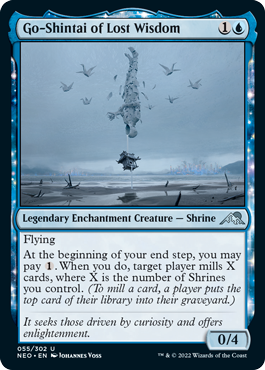
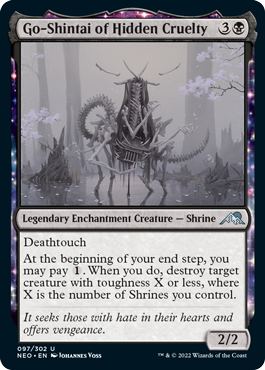
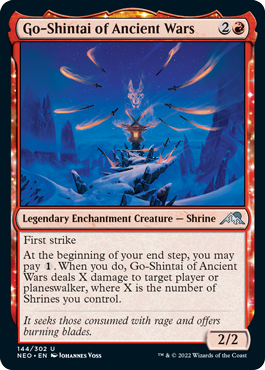
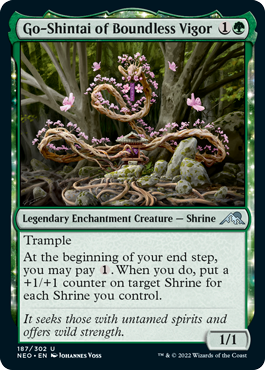
The Shrines first came about because we were playing around with the legendary theme in Champions of Kamigawa and thought it would be cool to make the very first legendary enchantments. The big question: why were they legendary? I don't mean flavorfully, as that was a much easier problem to solve. What kind of design made legendary relevant in a meaningful way? The answer from Brian Tinsman and his design team: enchantments with a new subtype that scaled with one another mechanically.
Although Champions of Kamigawa wasn't particularly popular when it released, the Shrines were one of the few high points of the set. They strongly appealed to a certain style of player and saw a decent amount of play. I would get asked on a regular basis for us to do more Shrines. R&D has a list of things that players often ask for, and more Shrines ended up on that list. It was decided that Shrines would be a nice addition to Core Set 2021, and we created six new ones, a five-card cycle and one five-color card.
Interestingly, this happened before "Hockey" (aka Kamigawa: Neon Dynasty) had started design. We didn't even know if it was going to be a Kamigawa set yet, so the Shrines ended up getting added to a product just two years shy of Kamigawa returning. This ended up being a little bit of a problem when we decided that "Hockey" should take place on Kamigawa. There weren't a lot of named mechanics returning, so we were eager to find popular cycles to bring back with new designs. The Shrines were the perfect cycle to bring back. They were originally popular. They were mechanically unique. They were iconically Kamigawan. The problem was the design space for them is limited.
The Shrines use what we call "scaling effects," that is, effects that can vary in size based on a number. We do scaling effects all the time, so we have a very good understanding of what scaling effects exist, and there aren't a lot, especially when you have to do a cycle involving all five colors. Okay, we wanted to bring them back, but Core Set 2021 had kind of used up the design space we would have used. Was there a different way to tweak them?
That's when we came up with the idea of them being enchantment creatures. I've been on a big kick to get enchantment creatures on more worlds than just Theros and had woven them into Kamigawa: Neon Dynasty's design as part of the means to show the tradition side of the world's conflict. Enchantment creatures were already a thing in the set, and making our Shrines into creatures opened up new design space. It also allowed us to use scaling effects that might be a bit strong on a global enchantment. Being creatures gave them an additional vulnerability that let us be more aggressive.
I thought it would be fun to look at the early designs of the five Shrines.
Tamashi of Unity (version 1)
3W
Legendary Enchantment Creature — Shrine
1/4
Vigilance
At the beginning of your end step, you may pay 1. If you do, create a 1/1 colorless Spirit creature token for each Shrine you control.
The printed white Shrine is almost identical to its initial version of it. The only change is it went from a 1/4 to a 1/3. Even the creature type of the creature token stayed the same. (It's a callback to original Champions of Kamigawa block.) As you will see, not all the initial versions had the mana payment with the trigger, but we liked how the white one played, so it ended up being a feature that ran across the whole cycle. I should also note that from the very beginning, we wanted each Shrine creature to have one creature keyword and one triggered scaling ability.
Tamashi of Resolve (version 1)
2U
Legendary Enchantment Creature — Shrine
1/3
Flying
Permanents you control have Spell Armor X, where X is the number of Shrines you control.
The earliest version of the blue Shrine granted ward to all your creatures with the number scaling on the number of Shrines. This version had several problems. One, high ward numbers on all your creatures is not particularly fun. Two, it removes the vulnerability that we liked with them being creatures. Three, it kind of gave the creature two named keywords, and we only wanted one.
Tamashi of Resolve (version 2)
2U
Legendary Enchantment Creature — Shrine
1/3
Flying
At the beginning of your end step, you may pay {o1}. If you do, untap up to X target nonland permanents, where X is the number of Shrine enchantments you control.
The next version played around with untapping things. It ended up not playing well, feeling more green than blue, as it was mostly about gaining mana.
Tamashi of Resolve (version 3)
2U
Legendary Enchantment Creature — Shrine
1/3
Flying
At the beginning of your upkeep, you may pay {o1}. If you do, target player mills twice X, where X is the number of Shrine enchantments you control.
The third version went with milling, an effect we tend to use a lot on blue scaling effects (as blue is one of the colors that has the trickiest time with appropriate scaling effects). It originally milled twice X because we were worried that X wouldn't be good enough. It ended up being a little too good. The last change took away the doubling of X and changed the creature from a 2U 1/3 to a 1U 0/4. This made it more defensive (something you want for a repeatable miller) and moved it away from the stats of white's Shrine.
Tamashi of Ambition (version 1)
3B
Legendary Enchantment Creature — Shrine
2/2
Deathtouch
At the beginning of your end step, you may pay 1. If you do, target creature an opponent controls gets -1/-1 until end of turn for each shrine you control.
The black Shrine's design didn't shift too much. The biggest change was that it went from a scaling -1/-1 effect to an effect that compared X to toughness. My best guess on this change was that they didn't want it killing indestructible creatures. The one other change is that it removed the restriction to only target an opponent's creatures. I think this was to line the cycle up, as none of the other Shrines were restricted to the opponents. (For example, we wanted the blue Shrine to be able to mill you because there are strategic reasons for doing that.)
Tamashi of Passion (version 1)
4R
Legendary Enchantment Creature — Shrine
2/3
Haste
Attacking creatures you control get +1/+0 for each Shrine you control.
The first version focused on combat making all your attackers stronger. The creature was given haste so that it could attack right away. It was a bit more expensive because the effect could be explosive.
Tamashi of Passion (version 2)
2R
Legendary Enchantment Creature — Shrine
2/2
Menace
At the beginning of your end step, you may pay {o1}. If you do, exile the top X cards of your library, where X is the number of Shrine enchantments you control. Until your next turn, you may play those cards.
The next version altered several things. First, it changed the scaling effect from power pumping to impulsive drawing. This was also when mana was added to the trigger. It changed from haste to menace, as haste was less synergistic with the rest of the card. Finally, it got cheaper and lost a toughness. The printed version of the card would go on to make two more big changes. Its scaling ability changed to direct damage, and instead of menace, it got first strike, I assume because it could combo with the damage (I hit a big creature, which will now die if you block my first striker.)
Tamashi of Growth (version 1)
1G
Legendary Enchantment Creature — Shrine
1/1
Trample
At the beginning of your end step, you may pay 1. If you do, put a +1/+1 counter on CARDNAME for each Shrine you control.
The first version of the green Shrine is almost identical to the printed version with just one big change. Instead of having to put the counters on itself, it's now allowed to put them on any target Shrine. This a common trick we do to make the card work by itself while adding in a little bit of tribal play.
I'm happy with how these ended up and glad Kamigawa: Neon Dynasty could add a new Shrine cycle to the mix.
Tamiyo, Compleated Sage
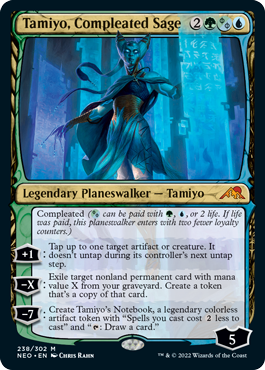
When we map out larger stories, one of the things we do is figure out the key story points. What are the big events that will garner the most attention? For Kamigawa: Neon Dynasty, we knew that Jin-Gitaxias was going to come to the plane, do some experimentation, and figure out something the Phyrexians have been trying to do forever—Phyrexianize a planeswalker without removing their spark (and thus remove their ability to planeswalk). This meant that the set had to have a Phyrexian planeswalker. This raised two big questions? One, which planeswalker? And two, what does being a Phyrexian planeswalker mean mechanically?
We started answering the first question by looking at what planeswalkers we expected to be in the set. We wanted to have the big reveal that The Wanderer was the emperor, so that meant The Wanderer was in the set. Tamiyo is from Kamigawa and a fan favorite, so she seemed like a sure include. We'd been wanting to make a Ninja planeswalker, so that felt like a perfect fit. Finally, for story reasons, we needed Tezzeret in the set. Of these four, who would be the best choice for the first Phyrexianization? Not Tezzeret. Not only is he working with the Phyrexians, but he's not someone the audience would be sympathetic toward if he were Phyrexianized. Kaito wasn't known by the audience, so there wasn't an emotional attachment yet. The Wanderer was a possibility, but she already had her big reveal in the set, so it was odd to give her two big reveals. That left Tamiyo.
The importance of a story point like this is that you want to hit the right tone. This was the big moment where everyone would realize that Phyrexians were resurfacing as a major threat, and we wanted to make a choice that would have a strong emotional impact. It needed to be someone the audience cared about, so the transformation would be meaningful. This moment of the story had to shock and scare the audience. The more we thought about it, the more we realized that Tamiyo was a perfect choice.
Which gets us to the second question? What does it mean to be a Phyrexianized planeswalker? I was given the task of figuring this out.
Tamiyo, Phyrexianized Scholar (version 1)
3GU
Legendary Planeswalker — Tamiyo
Loyalty – 3
0: Proliferate
-1: Return target card from your graveyard to your hand unless target opponent pays life equal to its mana value.
-6: You get an emblem with "Each permanent your opponents control doesn't untap during their controller's untap step unless they pay 2 life." Tap all nonland permanents you don't control.
The first version was created by Dave and his Set Design team. This was before I'd started to do my work. Their take on it was to focus on a named mechanic associated with the Phyrexians, proliferate. No planeswalker had proliferated before. The idea was that this would be the only proliferate card in the set. Her 0 ability acted like a +1 essentially, as it added a loyalty counter. The -1 allowed her to get extra cards and played into her scientist flavor. Her -6 ultimate allowed her to create a board state that felt very Phyrexian in its impact (as life payments are a big Phyrexian theme mechanically). While there were things I liked about the design, I just didn't think it felt Phyrexian enough. Proliferate is a great Phyrexian mechanic, but it requires a lot of support around it to capture the right feel. In a vacuum, it just didn't feel Phyrexian enough, so I set out to find something that would.
Other than proliferate, the other two mechanical elements that felt the most Phyrexian were poison and Phyrexian mana. I experimented with loyalty abilities that poisoned the opponent, but it was a little too all or nothing. I tried loyalty abilities with poison that poisoned you. That felt both off-flavor and had play design issues. I then turned to Phyrexian mana. I tried putting Phyrexian mana in the mana cost, but it just got cast using the two-life option every time Tamiyo was played. This led me to the idea of Phyrexian loyalty. What if it was a loyalty that you could pay two life for rather than mana? Loyalty abilities get used turn after turn, so it would be hard to always choose the life option.
Tamiyo, Phyrexianized Scholar (version 2)
3GU
Legendary Planeswalker — Tamiyo
Loyalty – 5
You may spend 2 life rather than 1 loyalty to activate CARDNAME's abilities.
-2: Draw two cards, then put a card from your hand on top of your library.
-2: Tap target creature or artifact. It doesn't untap during its controllers next untap step.
-3: Return up to one other target permanent card you control or from your graveyard to your hand.
Phyrexian loyalty didn't work well with an ultimate as you could always pay a bunch of life to do it right away. There was no way to make the player build up to it as with a normal planeswalker, so we instead chose three smaller abilities focused around loyalty costs of two or three. This version kept the effect of retrieving a permanent card from your graveyard but put it into your hand instead of onto the battlefield. It had a second card-drawing option, again playing up Tamiyo's scientist persona. The final ability allowed her to lock down artifacts and creatures.
Tamiyo, Completed Agent (version 3)
3GU
Legendary Planeswalker — Tamiyo
Loyalty – 5
You may spend 2 life rather than 1 loyalty to activate CARDNAME's abilities.
-1: Tap target creature or artifact. It doesn't untap during its controllers next untap step.
-3: Create a legendary artifact token named Tamiyo's Ledger with "{o2o(u/p)}, {oT}: Draw a card."
-3: Return up to one other target permanent card you control or from your graveyard to your hand.
The next version introduced an ability that fetched her journal (as we had seen in past Innistrad sets). This, for the first time, allowed us to get Phyrexian mana onto the card, albeit as an activation cost.
Play Design spent a lot of time with this card and eventually found the Phyrexian loyalty too powerful and too hard to balance. The new version put a Phyrexian mana in her mana cost but added a new restriction. Making Tamiyo cheaper would mean that she would enter with less loyalty. This allowed a more evenly distributed set of choices. The -1 ability became a +1 ability. Returning a permanent card from the graveyard reverted to the battlefield but changed to a -X loyalty cost to make her amount of loyalty more meaningful. Her ultimate was a new take on her journal. It still let you draw cards, but now without any cost, Phyrexian or otherwise. (Being an ultimate allows you to add significant power to effects.)
The other effect was new, allowing you to cast your spells more cheaply. Tamiyo was probably one of the most tested cards in the set, and after much tweaking of numbers, it ended up in its final form.
Story Time Is Over
That's all the time I have for today. I hope you enjoyed my card-by-card design stories. As always, I'm eager for any feedback, be it about this article, any of the cards I talked about or Kamigawa: Neon Dynasty as a whole. You can email me or contact me through any of my social media accounts (Twitter, Tumblr, Instagram, and TikTok).
Join me next week for my Kamigawa: Neon Dynasty mailbag column.
Until then, may you have fun making your own play stories with these cards to complement my design stories.
#907: NEO with Daniel Holt
#907: NEO with Daniel Holt
There's no one in R&D that's a bigger fan of Kamigawa than Daniel Holt. He worked on more Kamigawa: Neon Dynasty teams than any other person at Wizards, so I sat down with him to talk about how we made sure Kamigawa was well represented in the...
#908: Gods
#908: Gods
I walk through the history of the God creature type and share stories about how we designed the different incarnations of them.
- Episode 906 R&D Vocabulary, Part 5
- Episode 905 Kamigawa: Neon Dynasty Commander
- Episode 904 NEO with Dave Humpherys

